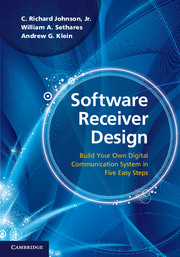Book contents
- Frontmatter
- To the Instructor …
- Contents
- Dedication
- Step 1 The Big Picture
- Step 2 The Basic Components
- Step 3 The Idealized System
- 4 Modeling Corruption
- 5 Analog (De)modulation
- 6 Sampling with Automatic Gain Control
- 7 Digital Filtering and the DFT
- 8 Bits to Symbols to Signals
- 9 Stuff Happens
- Step 4 The Adaptive Components
- Step 5 Putting It All Together
- Appendices
- Index
- References
6 - Sampling with Automatic Gain Control
from Step 3 - The Idealized System
Published online by Cambridge University Press: 05 June 2012
- Frontmatter
- To the Instructor …
- Contents
- Dedication
- Step 1 The Big Picture
- Step 2 The Basic Components
- Step 3 The Idealized System
- 4 Modeling Corruption
- 5 Analog (De)modulation
- 6 Sampling with Automatic Gain Control
- 7 Digital Filtering and the DFT
- 8 Bits to Symbols to Signals
- 9 Stuff Happens
- Step 4 The Adaptive Components
- Step 5 Putting It All Together
- Appendices
- Index
- References
Summary
As foreshadowed in Section 2.8, transmission systems cannot be fully digital because the medium through which the signal propagates is analog. Hence, whether the signal begins as analog (such as voice or music) or whether it begins as digital (such as mpeg, jpeg or wav files), it will be converted into a highfrequency analog signal when it is transmitted. In a digital receiver, the received signal must be transformed into a discrete-time signal in order to allow subsequent digital processing.
This chapter begins by considering the sampling process both in the time domain and in the frequency domain. Then Section 6.3 discusses how Matlab can be used to simulate the sampling process. This is not completely obvious because analog signals cannot be represented exactly in the computer. Two simple tricks are suggested. The first expresses the analog signal in functional form and takes samples at the desired times. The second oversamples the analog signal so that it is represented at a high data rate; the “sampling” can then be done on the oversampled signal.
Sampling and quantization are important because they translate the signal from analog to digital. It is equally important to be able to translate from digital back into analog, and the celebrated Nyquist sampling theorem shows that this is possible for any bandlimited signal, assuming the sampling rate is fast enough. When the goal of this translation is to rebuild a copy of the transmitted signal, this is called reconstruction.
- Type
- Chapter
- Information
- Software Receiver DesignBuild your Own Digital Communication System in Five Easy Steps, pp. 98 - 129Publisher: Cambridge University PressPrint publication year: 2011



